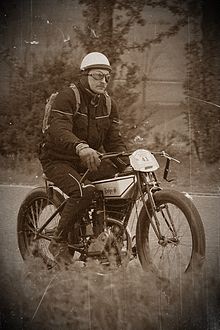Rudge
Rudge or Rudge-Whitworth was an English bicycle , motorcycle and automobile manufacturer in Coventry .
Rudge existed from 1910 to 1940. The spectrum of products ranged from motorcycles with a displacement of 250 cm³ to machines with a displacement of 1,000 cm³.
history
The Rudge-Whitworth company was based in Coventry. Dan Rudge began 1869 first in Wolverhampton with a bicycle production. At the same time there was Whitworth in Birmingham , which manufactured screws and other hardware . In October 1894 both companies came together and moved into their new headquarters in Crow Lane in Coventry. Initially, bicycles and wire-spoke wheels were still built . As early as 1907, the company developed such a wheel with a central lock . Spoked wheels with Rudge locks were used by many, mainly British, sports car manufacturers until the 1960s. Vehicle tires were also manufactured until the 1930s . In 1910 the first Rudge motorcycle was constructed with a single cylinder engine with IOE valve control and a displacement of 499 cm³. The first commercially available series model appeared on the market in 1911. A variable transmission called Multi Gear , which worked with expanding pulleys , soon followed.
Cyclecar
Between 1912 and 1913, a low two-seater cycle car with an air-cooled single-cylinder engine and 750 cc displacement was also produced under the brand name Rudge-Whitworth . The small car also received the multi-gear transmission, and the power was transmitted to the rear axle by means of a drive belt . The car was built for less than a year.
Heyday and decline
After the First World War, more motorcycles came onto the market, both for road traffic and as racing machines. At times Rudge ruled the racing season, and the robust and powerful engines retained a dominant position in racing for a short time after the Second World War, until the new developments finally overtook them.
Bankruptcy threatened in 1933 . The inevitable end came in 1936 when John Vernon Pugh, son of Whitworth's founder and the last survivor of the company's founding, passed away. The 1940 bombed in Coventry and not resurrected brand celebrated with their sporting achievements on the Isle of Man in 1928 to 1934 with the Senior TT - the junior TT -Siegen 1930 and the Lightweight TT -Siegen 1931 and 1934 their highlights. Rudge was also an engine supplier for other motorcycle brands such as B. Miller Balsamo .
Racing successes
In 1914, Rudge and his pilot Cyril Pullin won the senior race at the Tourist Trophy on the Isle of Man with an average speed of 79.18 km / h.
After the First World War there were some record drives before Rudge got back into racing in 1926. In 1927, all three Rudges who had started in the TT failed . But then 1928 was the great Rudge year: Graham Walker was leading by more than three minutes in the Senior TT when the connecting rod bearing ran out of steam seven kilometers from the finish. But then followed the victory at the Dutch TT in Assen , a second place in the German Grand Prix and finally, after a lap-long wheel-to-wheel battle, the victory against Charlie Dodson ( Sunbeam ) at the Ulster Grand Prix . This also gave birth to the “Ulster” model, which was available from 1929 as a replica of the racing machine.
In 1929 the TT was won again and with the drivers Graham Walker, Ernie Nott and Henry Tyrell-Smith many more races. In 1930, Nott drove a 500 cc Rudge on the Brooklands Railway in England to set the hour record of 170.38 km / h. A triple win at the Junior TT followed, and a week later Wal Handley won the Senior TT with a new record time of 119.47 km / h ahead of Graham Walker.
In the 1930s, the Berlin engine tuner Friedrich Brumm imported four-valve Rudge racing motorcycles to Germany. He made very successful racing machines out of them. a. Hans Richnow drove to many successes. Richnow became German champion in 1933 on a 350 cc Brumm Rudge, as these racing motorcycles were named after their master Brumm.
There were also Rudge racing motorcycles that were used in dirt track - (later called sand track races), sand and grass track races until after World War II. Hill climbs were also ridden on Rudge motorcycles.
In Austria, Helmut Krackowizer drove a two-valve 250 cc racing rudge very successfully in the post-war years.
European motorcycle championship
In total, Rudge was able to win four drivers' titles in the European motorcycle championship .
![]() Ernie Nott (2)
Ernie Nott (2)
- European champion in the 500 cm³ class: 1930
![]() Graham Walker (1)
Graham Walker (1)
- European champion in the 250 cm³ class: 1931
swell
- Helmut Krackowizer: Motorcycles - famous brands - from AJS to Zündapp. Welsermühl-Verlag, Wels / Munich 1981, ISBN 3-85339-170-2 .
further reading
- Reinhard Schwartz: The Family of Rudge. Testimonials of a Legendary Motorcycle / Contemporary witnesses of a legendary motorcycle brand. VMCC The Vintage Motorcycle Club, Burton upon Trent 2008, ISBN 978-0-9560312-0-4 .
- Nick Georgano : The Beaulieu Encyclopedia of the Automobile. Volume 3: P – Z. Fitzroy Dearborn Publishers, Chicago 2001, ISBN 1-57958-293-1 . (English)
- GN Georgano (Ed.): Complete Encyclopedia of Motorcars, 1885 to the Present. 2nd Edition. Dutton Press, New York 1973, ISBN 0-525-08351-0 . (English)
Web links
Individual evidence
- ^ Georgano: The Beaulieu Encyclopedia of the Automobile. 2001.





